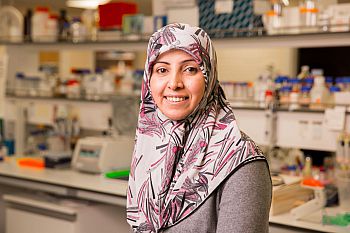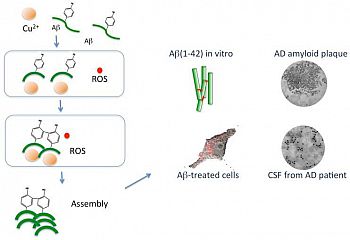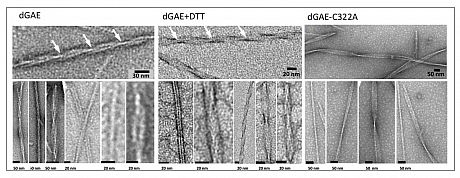Spotlight on Dr Youssra Al-Hilaly
Research Fellow in Biochemistry at the School of Life Sciences
Previous Research
 When I was young I really liked chemistry, especially organic chemistry, and I was inspired by my teacher at the time. He was really extravagant and helped me enjoy chemistry lessons and challenged me to solve his problems. I decided to then become a scientist and I did my undergrad in chemistry, and then my Master’s degree in biochemistry both in Iraq. In 2009, I moved to the UK to do my PhD here at Sussex with Professor Louise Serpell. I moved with my family, to Brighton. I decided to join Louise Serpell because I find that Alzheimer’s disease affects a lot of people that we care about, it affects our mum, grandpa, and even you might become one of them suffering from this disease.
When I was young I really liked chemistry, especially organic chemistry, and I was inspired by my teacher at the time. He was really extravagant and helped me enjoy chemistry lessons and challenged me to solve his problems. I decided to then become a scientist and I did my undergrad in chemistry, and then my Master’s degree in biochemistry both in Iraq. In 2009, I moved to the UK to do my PhD here at Sussex with Professor Louise Serpell. I moved with my family, to Brighton. I decided to join Louise Serpell because I find that Alzheimer’s disease affects a lot of people that we care about, it affects our mum, grandpa, and even you might become one of them suffering from this disease.
During my PhD, I investigated and studied the pathogenesis of both Alzheimer’s disease and Parkinson’s disease. Parkinson’s disease is like Alzheimer’s disease, it is a neurodegenerative disease that affects the brain and neurons as well. In both diseases, proteins misfold to form amyloid fibrils, which are deposited in the brain. High oxidative stress has been observed and metal ions, especially copper, have been shown to be involved in the pathogenesis of both Alzheimer’s and Parkinson’s diseases. My research showed that dityrosine cross-linking may be a common mechanism by which amyloid fibril assembly is triggered and stabilized. There is no definite drug target for Alzheimer’s disease or Parkinson’s disease, which is a major challenge for drug discovery. Understanding the mechanisms associated with the pathogenesis of Alzheimer and Parkinson’s diseases will enable the discovery of new targets. Researchers hope to develop therapies targeting specific genetic, molecular, and cellular mechanisms so that the actual underlying cause of the disease can be halted or prevented. Once I submitted my thesis, Louise offered me a post-doctoral position and I continued with the same subject.

Current Research
My current project focuses both on understanding the mechanism underlying Alzheimer’s disease, and understanding the mechanism of a promising new drug, produced by TauRx, that targets Tau protein. Tau protein is one of the proteins involved in the development of Alzheimer’s disease. Tau protein misfolds to form pair helical filaments that clump together in tangles that destroy the neurons of the brain. The pharmaceutical company TauRx have developed a new drug which specifically targets Tau protein and inhibits/disassembles its aggregation. The company published their data recently showing that the drug can be used as a monotherapy for Alzheimer’s disease, so we are all excited about this. The clinical trial has taken the company at least 10 years but we are nearly there. My job is to understand the molecular mechanisms of the drug and how it works, but by first understanding the mechanisms underlying the disease, you can then understand how the drug works. Recently, I have published a paper showing that truncated form of tau assembles into Alzheimer’s like paired helical filaments in vitro without the need for other additives to initiate the process. Using an electron microscope, circular dichroism and X-ray fibre diffraction, I have characterised the structure of the fibrils formed from truncated tau for the first time.

Alzheimer’s disease is one of the most challenging diseases to study, it is very hard to tell what causes the disease, is it genetics or is it lifestyle? This is something that researchers from the field still argue about. The evidence for both is quite strong and there are several hypotheses on what causes Alzheimer’s. The problem with studying how to prevent Alzheimer’s is that you can only focus on one hypothesis at a time. Since its discovery in 1906 no cure has yet been found.
Through my work I demonstrated direct physiological evidence for the involvement of dityrosine cross-linking in both Alzheimer's disease and Parkinson's disease. This was the first time this was proven and was a very big achievement that I am proud of. By establishing that dityrosine cross-linking is a mechanism that underlies both Alzheimer's disease and Parkinson's disease, we have identified a new target that people could discover drugs for. The results were published in two papers and we secured funding to carry on with our project.
We have lots of facilities here at Sussex that make it really possible to do research on Alzheimer’s disease. We have a new neuroscience department, an electron microscopic centre that we really need for this study, and a genome centre. All of these centres are needed to carry out Alzheimer’s research and is what convinced me that Sussex is a good place to research the disease. We now have a new doctoral centre on Alzheimer’s disease and have big groups that collaborate together trying to find answers to questions about cause and treatment.
The Future
It is very challenging being a mum with four kids and be a scientist, but I can't imagine my life without science. I would like to do teaching and research together and I will try my best to carry on with this. At this stage I don't mind not working in my own lab because in our lab, Louise Serpell gives us freedom to design our experiments and to follow what we think. It’s as if everybody has their own small lab within a big lab and we are able to suggest crazy ideas.
Interview by Alex Aghajanian

